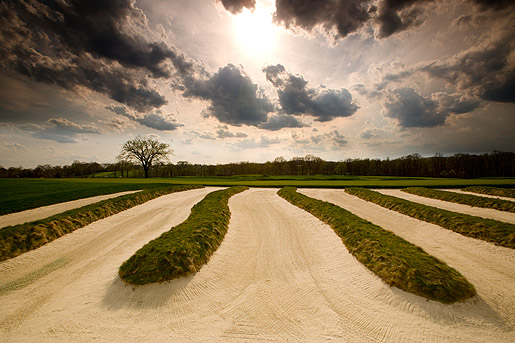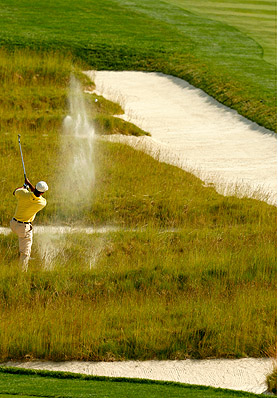Oakmont’s Fatal Attraction
At This Golf Cathedral, It’s Best To Avoid The (Church) Pews
 |
The Church Pews bunker between the third and fourth holes at Oakmont Country Club consists of 26,000 square feet of sand and 102 yards long and 42 yards across at its widest end. (John Mummert/USGA) |
April 29, 2010
By Gerry Dulac
Nature’s cruelties can be coupled with golf courses, linked to their character the way a scent attaches to a rose. Winds that whip off the Firth of Clyde buffet shots at Turnberry. Pine trees you can smell on Washington Road torment players and determine shot shape at Augusta National. Waves crashing against the sea wall throw mist and cull wayward shots at Pebble Beach.
It’s doubtless, though, that any golf course in America, perhaps even in the world, is as intrinsically linked with a hazard as Oakmont (Pa.) Country Club is with the Church Pews bunker, a beast of a sand hazard that is named for piety but can elicit profanity. Perhaps only the Road Hole at St. Andrews can compare, though its diabolical taunts are more a by-product of rapture and intrigue than draconian penalty.
“Everyone looks forward to seeing the Church Pews in person,” said Bob Ford, Oakmont’s head golf professional since 1975. “But they certainly don't want to get too close.”
It is 26,000 square feet of sand and wispy, grassy ridges, 102 yards long and 42 yards across at its widest end, situated between the third and fourth holes at Oakmont, site of the 2010 U.S. Women’s Open. It is to the club what the pyramids are to Egypt – a landmark that everyone wants to visit and photograph but in which nobody wants to get stuck.
“Some of the coolest bunkers in the game," Phil Mickelson said when he played in the U.S. Open in 2007.
The bunker is so named because the 12 grassy berms inside the massive sand hazard look like benches – or pews in a church. A
 |
Everyone who plays Oakmont Country Club wants to look at the Church Pews bunker, but nobody wants to hit into it. (John Mummert/USGA) |
“It was always so intimidating," said Larry Nelson, who won the Open there in 1983, beating Tom Watson on a rain-soaked Monday. “It's luck of the draw as to where your ball is in those things. You might or might not have a shot. You are so careful to avoid them."
Tiger Woods refused to hit practice shots out of the Church Pews in 2007, swearing he would avoid them at all costs during the U.S. Open and saying he doesn’t like to “practice negativity.” The only time the world’s No. 1 player stepped into the sandy beast was for an American Express photo opportunityseveral weeks before the championship.
Used to be, the Church Pews, like all the other bunkers at Oakmont, were groomed with a special rake with wider tines, creating deep furrows in the sand. But the rakes were last used in U.S. Open competition in 1962, when Jack Nicklaus beat the hometown hero, Palmer, in an 18-hole playoff, and they were eventually eliminated from use in 1964.
But that didn’t prevent the Church Pews from becoming even more maddening.
The original Oakmont layout, designed by course founder H.C. Fownes in 1903, did not include the Church Pews bunker. Sand seemed to be everywhere else, though.
Oakmont once had 350 bunkers, in part because Fownes, without any water on his farmland property, started putting bunkers wherever a shot might land without penalty. During the 1927 U.S. Open, the left side of the third hole was a series of six separate bunkers.
By the time the 1935 Open came to Oakmont, those six separate bunkers were unified into one sprawling bunker with six grassy berms – each section of bunker only four inches deep. The Church Pews were born.
Then, like feeding a giant, the hazard kept growing. The Church Pews were extended to eight berms in 1973 and, in 2005, to get ready for the ’07 U.S. Open, two more pews were added on each end, bringing the total number to 12. The grass on the berm – a mixture of blue, rye and fescue – was replaced with 100 percent fescue, creating the wiry look that exists today.
What’s more, the pews were deepened to 3 to 3½ feet, making the footing precarious and potentially hazardous to one’s health should a shot have to be played from atop one of the berms.
As part of the facelift, the sand in the hazard, once coarse, was replaced with whiter, softer sand that was more visually appealing for television but also more likely to result in buried lies, making recovery even more difficult. There is about four to five yards of sand between each pew.
“They are truly one of the most recognized design elements in golf,” said two-time Masters champion Ben Crenshaw, a historian of the game and course designer. “There's really nothing else like them. They are uniquely Oakmont.”
Amen.
Gerry Dulac covers golf for the Pittsburgh Post-Gazette and occassionally writes for usga.org.
